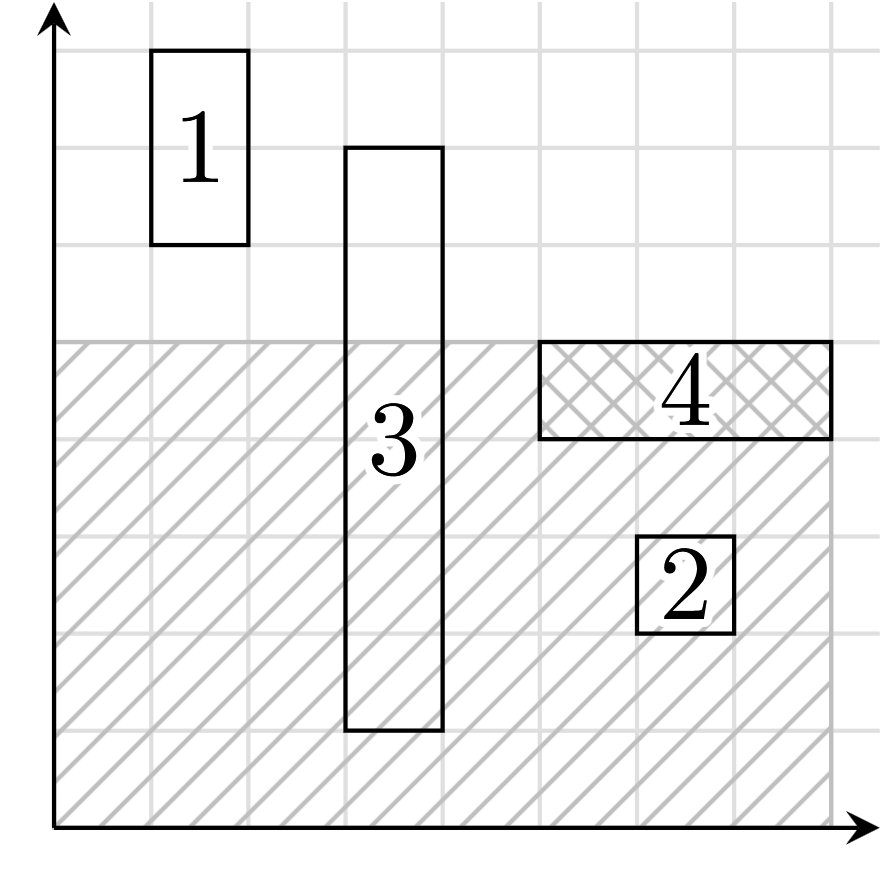
USACO 2025 US Open Contest, Platinum
Problem 1. Forklift Certified
Contest has ended.

Log in to allow submissions in analysis mode
Farmer John is training to become forklift certified! As part of his training, he needs to clear $N$ ($1 \le N \le 10^5$) boxes, conveniently labeled $1$ through $N$, from an old warehouse.
The boxes can be modeled as axis-aligned rectangles in a 2-dimensional plane, where the $+x$-direction is east and the $+y$-direction is north. Box $i$ has its southwest corner at $(x_{i1},y_{i1})$ and its northeast corner at $(x_{i2},y_{i2})$. All coordinates are integers in the range $[1, 2N]$, and no two corners from two different rectangles share the same $x$ or $y$ coordinate. All boxes have a non-zero area, and no two boxes intersect.
Farmer John plans to remove the boxes one at a time out of the southwest entrance of the warehouse. However, he can only remove a box if no part of any other box lies both south and west of the box's northeast corner due to physical limitations of the forklift.
An example with $N=4$ is shown below. To remove box $4$, there cannot be any other boxes in the shaded region. Boxes $2$ and $3$ prevent box $4$ from being removed, but box $1$ does not.

Help Farmer John decide how to remove all the boxes! Your code should operate in two separate modes, defined by an integer flag $M$:
- Mode 1 ($M = 1$): Generate a permutation of $1, \dots, N$ specifying a valid box removal order. If there are multiple valid orders, find any. It can be proven that such an order always exists.
- Mode 2 ($M = 2$): For each $k = 1, \dots, N$, output $\texttt{1}$ if Farmer John can remove box $k$ if boxes $1, \dots, k - 1$ have already been removed, and $\texttt{0}$ otherwise.
INPUT FORMAT (input arrives from the terminal / stdin):
Each input consists of $T$ ($1 \le T \le 10$) independent test cases. It is guaranteed that the sum of all $N$ within each input does not exceed $5 \cdot 10^5$.
The first line of input contains $T$ and $M$. (Note that $M$ is the same for each test case.) Each test case is then formatted as follows:
- The first line contains a single integer $N$.
- Each of the next $N$ lines contains four space-separated integers $x_{i1}, y_{i1}, x_{i2}, y_{i2}$: the locations of the southwest and northeast corners of box $i$.
OUTPUT FORMAT (print output to the terminal / stdout):
For each test case:
- If $M = 1$, output a single line with $N$ space-separated integers, where the $j$-th integer is the label of the $j$-th box to remove.
- If $M = 2$, output a single line with a binary string of $N$ characters specifying the answer for each $k = 1, \dots, N$.
SAMPLE INPUT:
2 1 4 1 6 2 8 6 2 7 3 3 1 4 7 5 4 8 5 3 1 5 3 6 4 1 5 2 2 3 6 4
SAMPLE OUTPUT:
1 3 2 4 2 3 1
The first test case corresponds to the $N = 4$ example above. Box $1$ is not blocked by anything, box $3$ is blocked by box $1$, box $2$ is blocked by box $3$, and box $4$ is blocked by boxes $2$ and $3$.
SAMPLE INPUT:
2 2 4 1 6 2 8 6 2 7 3 3 1 4 7 5 4 8 5 3 1 5 3 6 4 1 5 2 2 3 6 4
SAMPLE OUTPUT:
1011 011
For the first test case, box $2$ is blocked by box $3$, so Farmer John cannot remove it before removing box $3$.
SCORING:
- Inputs 3-5: $M = 1$, $N\le 1000$.
- Input 6: $M = 2$, $N \le 1000$.
- Inputs 7-13: $M = 1$, no additional constraints.
- Inputs 14-16: $M = 2$, no additional constraints.
Problem credits: Austin Geng